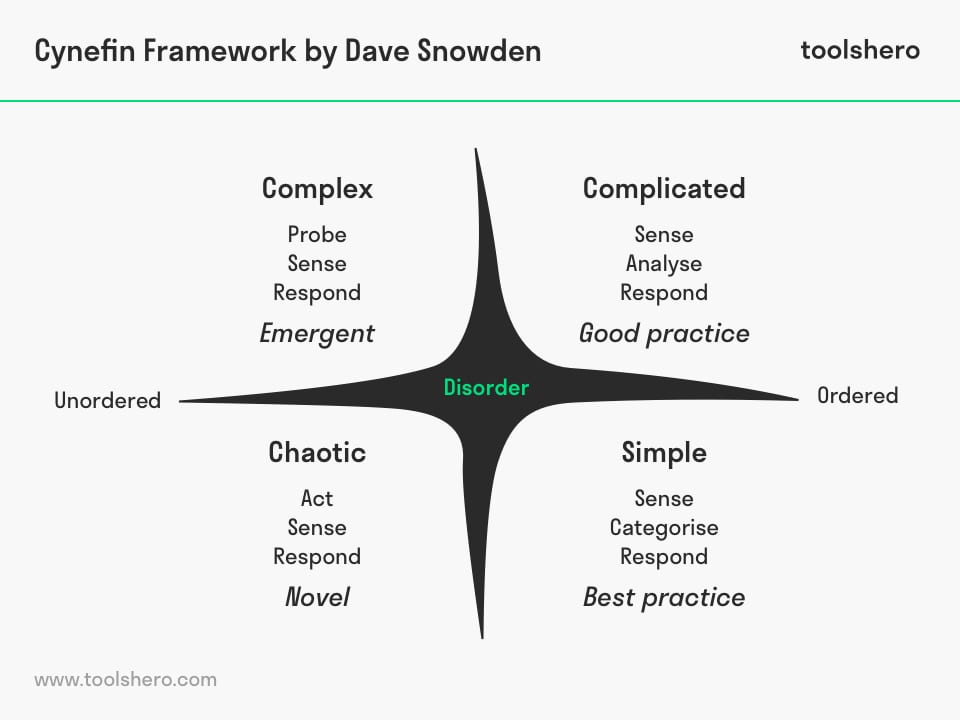Cynefin Framework (Snowden)

Cynefin Framework: this article explains the Cynefin Framework, developed by Dave Snowden and Mary E. Boon, in a practical way. The article starts with general theory of this framework, followed by an example of contexts in which this model is used and tips for practical application. Enjoy reading!
What is the Cynefin Framework?
The Cynefin Framework distinguishes five different contexts of decision making, allowing organisations to make better decisions and to understand people’s behaviour.
Effective leaders know that there is no one-size-fits-all strategy for problem solving. Situations change constantly, and leaders make good decisions by adapting and reacting to these changes. However, mistakes are made easily. How do we know which problem solving strategy to use at which point in time? How do we prevent making expensive mistakes?
As European director of the computer company IBM, Dave Snowden was the person to introduce the Cynefin Framework in 1999. Together, he and Mary E. Boon outlined the Cynefin Framework in the Harvard Business Review.
What is the Cynefin framework in simple terms? The context
The word Cynefin is a Welsh word, stemming from the Welsh language. It means ‘habitat’, ‘familiar’ and ‘acquainted’. The Cynefin Framework offers decision-makers within an organisation a context and a perspective from which to view their observations.
When the context within which organisations work is better understood, successful ways can be identified to help organisations change. The Cynefin Framework clarifies which behaviour works successfully in a specific context.
Domains within the Cynefin Framework
The Cynefin Framework offers five contexts of decision-making, which are also referred to as domains: Simple, Complicated, Complex, Chaotic and Disorder at the centre.
The domains offer a ‘sense of place’ from which to analyse behaviour and make decisions. The domains offer managers a framework on how best to act in comparable situations. The framework helps them to display the best practice within a variety of situations.
The Cynefin Framework looks like this; on a horizontal axis, the left side is ‘unordered’ and right side ‘ordered’.
Adding a vertical axis, four domains are created; Complex (top left) versus Chaotic (bottom left) and Complicated (top right) versus Simple (bottom right). The centre of the framework is undefinable and therefore referred to as Disorder.

Figure 1 – Cynefin Framework (Snowden & Boon)
Cynefin Framework: Cause and effect
In the ordered domains on the right (Simple and Complicated) cause and effect are known and if not, can be easily identified. In the unordered domains on the left (Complex and Chaotic) cause and effect can only be deduced in hindsight or not at all.
The cause-effect mechanism is related to a modern world view in which organisations are perceived as partnerships, and in which specific situations prompt predictable responses.
However, an organisational structure doesn’t give a clear picture of how people interact within an organisation. An organigram is a simplified version of reality. Within organisations, people collaborate and enter into social relationships, which are often vital to the functioning of the organisation as a whole. Each situation and each context is different and from that vision, the Cynefin Framework can help.
Simple context
Within the Simple context, cause and effect are predictable and clear to everyone within the organisation. There are procedures and predetermined rules and nothing is left to chance, making the outcome as good as known. This concerns standard work processes, legal structures and proven practice.
The procedure is as follows: Sense, Categorise, Respond. Firstly, establish the facts. Secondly, these facts must be accurately categorised in order to be able to respond correctly and in accordance with the rules and applying best practice in the end.
Complicated context
In the Complex context, too, there’s a definable cause-effect relationship. It consists of the ‘known unknowns’. The complicated nature requires thorough analysis of the situation in order to fully comprehend it. There’s a range of right answers available, but they’re not obvious. This domain requires experts, able to analyse and ultimately determine which response will be best in certain situations.
The framework recommends: Sense, Analyse, Respond. Here, too, the facts must be established first, followed by a thorough analysis of the available information. Only then can appropriate good operating practice be applied. It’s possible to work rationally toward a decision, but doing so requires refined judgment and expertise.
Complex context
The Complex context sits within the domain of disorder. Cause and effect can only be deduced in retrospect, making an advance analysis unnecessary. Behaviour is unpredictable and there are no right answers. A complex organisation is constantly changing, making experimentation an effective tool.
The framework recommends: Probe, Sense, Respond. Firstly, it’s wise to implement different methods and experiment with them. There’s no singular method that leads to guaranteed success. Next, the result the earlier experiment had must be determined. We are dealing with unpredictable situations, prone to quick change. By responding to this as well and as flexibly as possible, the complex context can be bridged.
Chaotic context
In the chaotic context, cause and effect are unclear and events are often confusing and surprising. It is characterised by crises and emergencies. Nobody knows what’s going to happen in advance and nobody knows which action is best in the moment. There’s barely any time to consult and it often involves instinctive and quick responses, where the resolution of the emergency situation and the removal of the initial panic are paramount.
The framework recommends: Act, Sense, Respond. First, the emergency situation must be stabilised. All actions are derived from this. From this point the result observed and the need for continuation determined. There must be a continuous assessment of whether stability has been established. If this is not the case, then the appropriate response is to apply new and different actions.
Cynefin Framework and Disorder
Disorder or Confusion is difficult to trace or define. It lies at the centre of all domains. In such a case, a company can choose to break down the situation into smaller parts and assign each to one of the other four domains. Leaders can then make decisions and intervene in contextually appropriate ways. As knowledge increases, there’s a “clockwise drift” from chaotic through complex and complicated to simple.
Practical Application of the Cynefin Framework
After its development, the Cynefin Framework was used by IBM developers for, among other things:
- Policy making
- Product development
- Market creation
- Supply chain management
- Branding
- Customer relationship management
Subsequently, the application of the framework was expanded to include, for example, disaster management, network science, food chain risk management, homeland security in the United States and Agile/Lean software development.
Cynefin Framework Criticism
A common criticism this framework receives, is that it is difficult to use. In addition, it is said to be confusing and incomplete. A more solid foundation is needed and the framework contains too few possible contexts.
Another criticism is that the terminology used is ambiguous. Words such as known, knowable, meaningful and categorising are said to be ambiguous.
Professor Simon French recognises the value of the Cynefin Framework, particularly in categorising decision contexts.
It’s Your Turn
What do you think? Is the Cynefin Framework applicable in your personal or professional environment? Do you recognize the practical explanation or do you have more suggestions? What are your success factors for good decision making and understanding the different effect of certain behavior?
Share your experience and knowledge in the comments box below.
More information
- Childs, S., & McLeod, J. (2013). Tackling the wicked problem of ERM: using the Cynefin framework as a lens. Records Management Journal, 23(3), 191-227.
- Snowden, D. (2005). Strategy in the context of uncertainty. Handbook of Business strategy, 6(1), 47-54.
- Snowden, D. J., & Boone, M. E. (2007). A leader’s framework for decision making. Harvard business review, 85(11), 68.
How to cite this article:
Mulder, P. (2018). Cynefin Framework (Snowden). Retrieved [insert date] from Toolshero: https://www.toolshero.com/decision-making/cynefin-framework/
Original publication date: 05/18/2018 | Last update: 11/11/2023
Add a link to this page on your website:
<a href=”https://www.toolshero.com/decision-making/cynefin-framework/”>Toolshero: Cynefin Framework (Snowden)</a>






